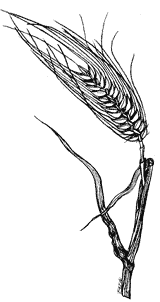 By Steven Horne and Paula Perretty
By Steven Horne and Paula Perretty
We don’t often think of grass as food because our digestive tracts lack the enzyme cellulase, which is necessary to convert cellulose into sugars. So, we can’t get sufficient calories from grass to use it for fuel the way cows, horses, sheep and other grazing animals can. Still, the reason these mammals can live entirely on grass is because it contains all the nutrients needed to support mammalian life. This makes grass an incredible, natural nutritional supplement for us.
One of the most nutritious grasses on the planet for human beings is barley. Only wheat is comparable. Barley’s history as a food began in the Stone Age, 8500 years ago and it has been cultivated early as 7000 BC. The grain, sprouted grain and the grass have all been used for food and healing.
Roman gladiators ate barley grain for strength and stamina. Dioscorides, recommended it “to weaken and restrain sharp and subtle humours and sore and ulcerated throats.” In more recent times, Culpepper wrote, “barley flour, white salt, honey, and vinegar mingled together taketh away the itch speedily and certainly.” Today, cool barley water is still used in drinks for fevers and to soothe and heal stomach or digestive upsets, irritable bowels, dry coughs, diarrhea, cystitis or irritable bladders.
In modern herbalism, the dehydrated powder of barley juice is also used as a natural nutritional supplement to build general health. Barley grass is a powerhouse of nutrition, containing 11 times the calcium in cows’ milk, nearly 5 times the iron in spinach, 7 times the vitamin C in oranges, and 80 mg. of vitamin B12 per hundred grams. It is a natural and safe way to get a balance of vitamins and minerals, as well as a number of not so familiar nutrients.
For instance, barley grass is a good source of chlorophyll, the green pigment found in most plants that is responsible for taking energy from light and turning it into food for the plant. For humans and animals, chlorophyll increases the oxygen carrying capacity of the blood and prevents red blood cells from sticking together.
Barley also contains beta glucans, a polysaccharide also found in oat and wheat bran and Shiitake mushrooms. B-glucans have been found to regulate blood sugar, reduce blood cholesterol levels, and help prevent bowel cancer. They stimulate the immune system and have been used in cancer therapy in Japan since the 1980s. Trials undertaken in the 1990s, suggest that the glucans in barley may be helpful in controlling blood-sugar levels in diabetics.
The young shoots of barley grass also contain glutamic acid, methionine and alpha-linoleic acid. The body uses glutamic acid to recharge antioxidants. Methionine is an important amino acid that is used by the body for the synthesis of other amino acids and for the production of SAM-e. Alpha-linoleic acid is an important antioxidant.
Research published as recently as September 2005 notes that one of the principal growth factors in the barley shoot is the hormone melatonin. This finding may explain the calming effect of the herb.
In modern complementary medicine, barley grass is often prescribed when the diet fails to provide a full range of nutrients. Green juices protect the liver and gall bladder from the harmful effects of bad fats and support the functions of the heart. Green juices also neutralize acids in the muscles, making it an excellent choice after strenuous exercise.
Barley and barley grass are excellent foods for the convalescent, infants and the infirm. Since it is so easily digested, it doesn’t put stress on the liver.
Barley juice powder is an ingredient in GreenZone, Energ-V and Defense Maintenance. Roasted barley grain is found in Herbal Beverage. Roasted barley is a healthy substitute for coffee and benefits the liver. Barley juice powder is also available as a single remedy in capsules and NSP Canada offers a unique product of barley sprouts called Nature’s Gold.
Selected References
- Juicing Therapy by Dr. Bernard Jensen
- The Comprehensive Guide to Nature’s Sunshine Products by Tree of Light Publishing
- Herbal Information Center: www.kcweb.com/herb/barley.htm

